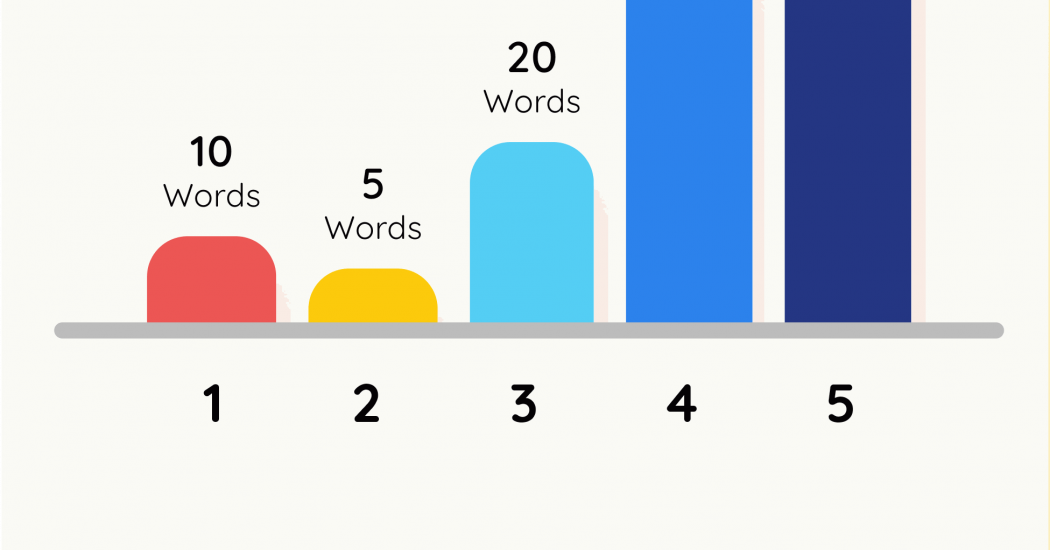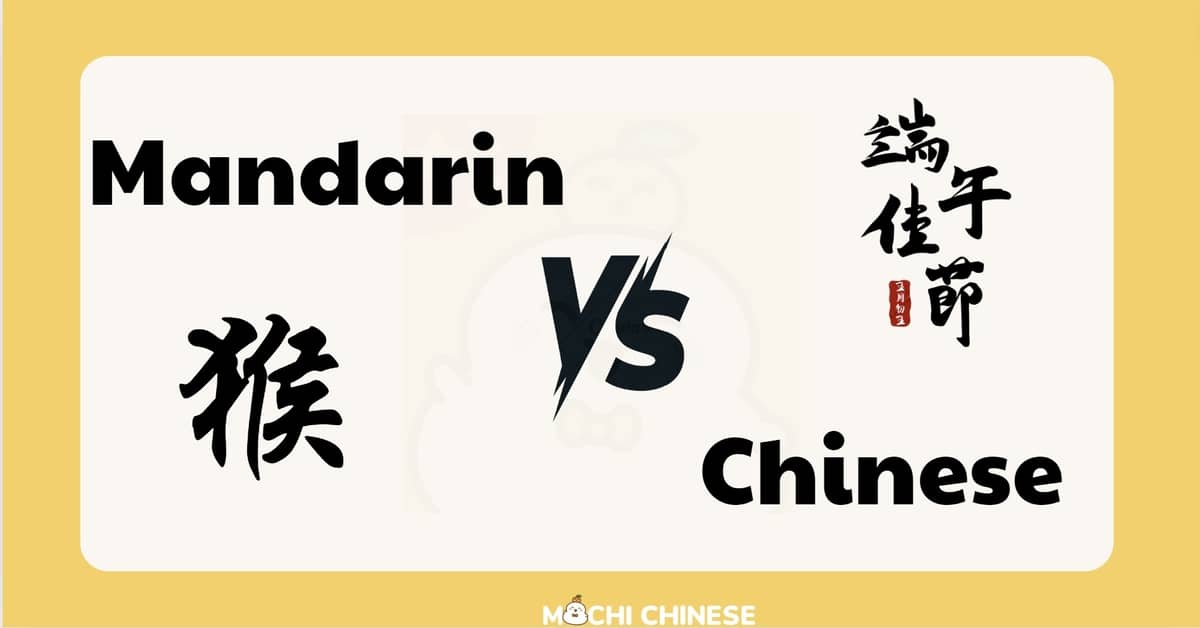I. Introduction to Pinyin
A. What is Pinyin? Why do we need to learn Pinyin when starting to learn Chinese?
B. Overview of Pinyin System
II. Learning Initials (Consonants)
III. Learning Finals (Vowels)
IV. Learning Tones
V. Combining Initials, Finals, and Tones
VI. Learn Chinese Vocabulary easily after master chinese alphabet pinyin
I. Introduction to Pinyin
A. What is Pinyin? Why do we need to learn Pinyin when starting to learn Chinese?
1. Pinyin is a phonetic system for representing Mandarin Chinese sounds.
Pinyin serves as a phonetic system specifically designed to represent the sounds of Mandarin Chinese using the Latin alphabet. It was developed by the Chinese government in the 1950s to aid in the teaching and learning of Mandarin pronunciation, particularly for speakers of languages that use the Latin script.
Each letter or combination of letters in Pinyin corresponds to a specific sound in Mandarin Chinese. This allows learners to associate the pronunciation of Mandarin words with familiar letters from the Latin alphabet. Pinyin follows a systematic structure, with each syllable consisting of an initial (consonant), a final (vowel or vowel combination), and optionally a tone marker. This structured approach helps learners understand the phonological makeup of Mandarin syllables.
One crucial aspect of Pinyin is its representation of tones. Mandarin Chinese is a tonal language, meaning that the pitch or tone contour of a syllable can change its meaning. Pinyin uses tone markers (diacritics) to indicate the tone of each syllable, distinguishing between the four main tones (1st, 2nd, 3rd, and 4th) and the neutral tone.
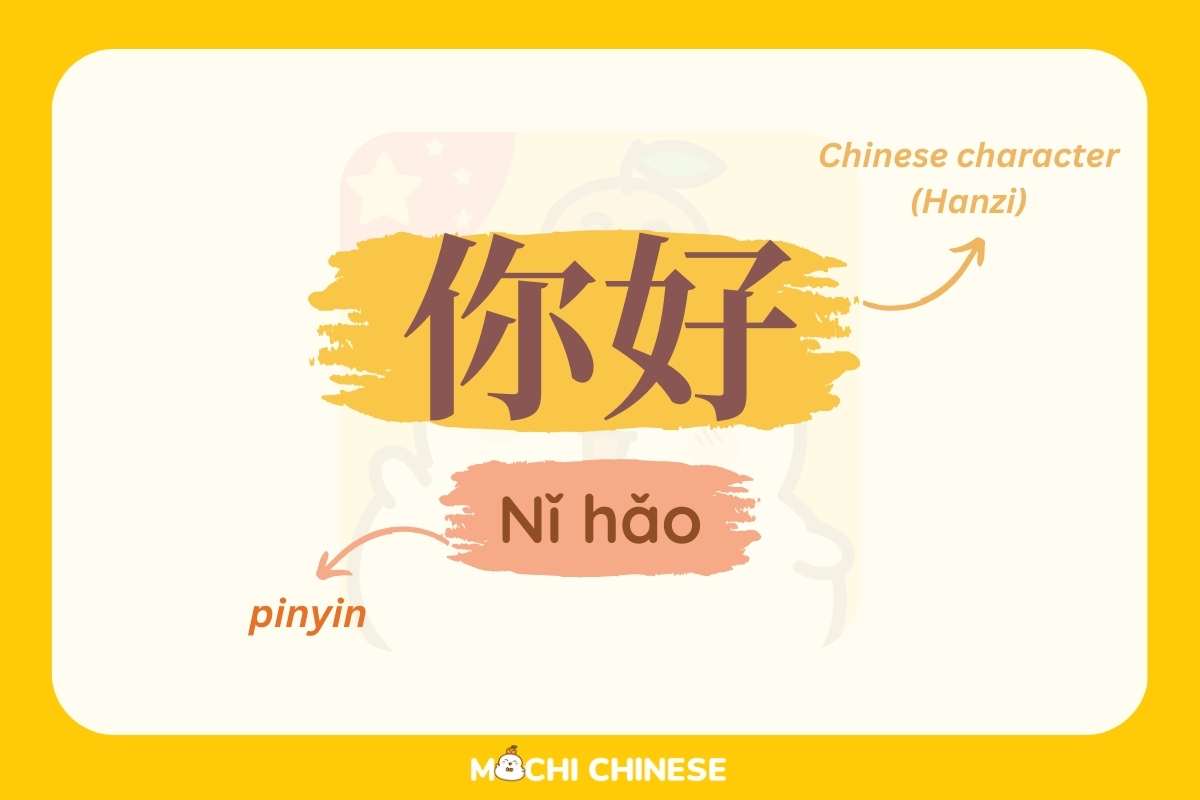
2. Importance of Pinyin in learning Chinese pronunciation and characters.
Pinyin provides a standardized way to represent Chinese pronunciation, facilitating communication and comprehension among speakers of different dialects or regions within China. It helps learners and speakers achieve more accurate and consistent pronunciation of Mandarin words.
Pinyin serves as a valuable learning aid for both native speakers and learners of Mandarin Chinese. For beginners, it provides a phonetic guide to pronunciation, making it easier to learn and remember new words. For more advanced learners, it aids in the study of pronunciation nuances and helps with reading and writing Chinese characters.
B. Overview of Pinyin System
Now, let’s delve into the fundamentals of Mandarin Chinese pronunciation by exploring its three key components: initials, finals, and tones in the Pinyin system.
Initials (声母 – shēngmǔ):
Initials are the initial consonant sounds of a syllable in Mandarin Chinese. There are 21 initials in Mandarin Chinese Pinyin system.
Finals (韵母 – yùnmǔ):
Finals are the vowel and nasal sounds that follow the initials in a syllable. There are various finals in Mandarin Chinese.
Tones (声调 – shēngdiào):
Mandarin Chinese is a tonal language, which means the tone in which a syllable is pronounced can change its meaning. There are four main tones and one neutral tone in Mandarin Chinese.
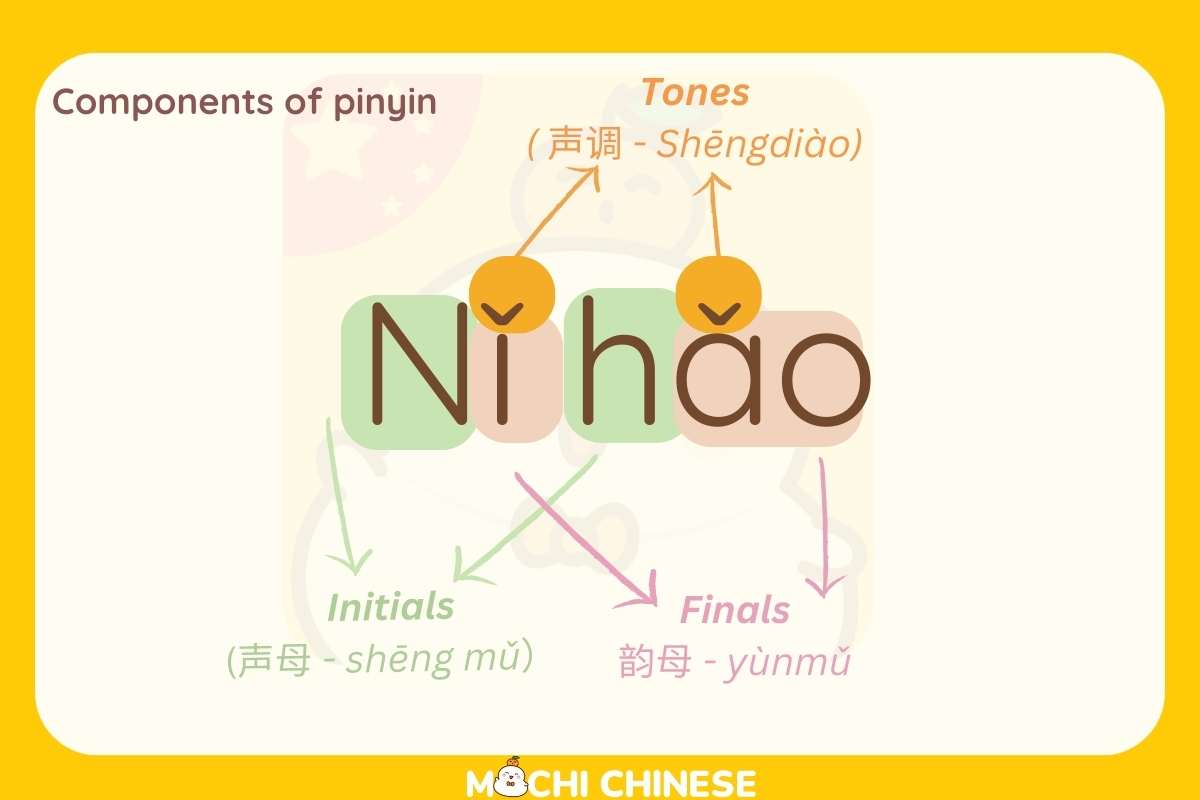
II. Learning Initials (Consonants)
The “initials,” or 声母 (shēngmǔ), which denote the consonant sounds that begin syllables. Understanding these initials is essential for mastering Mandarin pronunciation. Let’s explore the initials in the Pinyin system
21 initials in Mandarin Pinyin and pronunciation guide for each initial
Mandarin Chinese features 21 initials, encompassing various consonant sounds. These initials are:
- b (b): Represents the sound similar to the English “p” in “pen”. Example: “bā” (八 – eight).
- p (p): Also represents the sound similar to the English “p” in “pen” but with more force and pushing the airflow out of the mouth. Example: “píngguǒ” (苹果 – apple).
- m (m): Represents the sound similar to the English “m.” Example: “māma” (妈妈 – mother).
- f (f): Represents the sound similar to the English “f” in “fun” Example: “fēng” (风 – wind).
- d (d): Represents the sound similar to the English “t” in “too”. Example: “dà” (大 – big).
- t (t): Represents the sound similar to the English “th” in “thanks” but with more force and pushing the airflow out of the mouth. Example: “tā” (他 – he).
- n (n): Represents the sound similar to the English “n” in “nice”. Example: “nǚ” (女 – woman).
- l (l): Represents the sound similar to the English “l” in “like”. Example: “lù” (路 – road).
- g (g): Represents the sound similar to the English “c” in “cat”. Example: “gǒu” (狗 – dog).
- k (k): Represents the sound similar to the English “k” in “kick” but with more force and pushing the airflow out of the mouth. Example: “kè” (课 – class).
- h (h): Represents the sound similar to the English “h” in “hand”. Example: “hǎo” (好 – good).
- j (j): Represents the sound similar to the English “j” as in “jump.” Example: “jiā” (家 – home).
- q (q): Represents a sound similar to “ch” in “cheese” but with the tongue against the lower teeth. Example: “qián” (钱 – money).
- x (x): Represents a sound similar to the English “see”. Example: “xiǎo” (小 – small).
- zh (zh): Represents a sound similar to the “ch” in “church” Example: “zhōng” (中 – middle).
- ch (ch): Represents a sound similar to the “ch” in “church”but with more force and pushing the airflow out of the mouth. Example: “chī” (吃 – to eat).
- sh (sh): Represents a sound similar to the “sh” in “shoe.” Example: “shū” (书 – book).
- r (r): Represents a sound similar to the “r” in Spanish “pero” or the “r” in French “paris.” Example: “rén” (人 – person).
- z (z): Represents the sound similar to “dz” sound (although the “d” is not voiced). It’s like the “ds” you hear in the English words “kids”. Example: “zi” (子 – child).
- c (c): Represents a sound similar to the “ts” sound. It’s like the “ts” you hear in the English words “cats”. Example: “cǎo” (草 – grass).
- s (s): Represents the sound similar to the English “s” in “some”. Example: “sān” (三 – three).
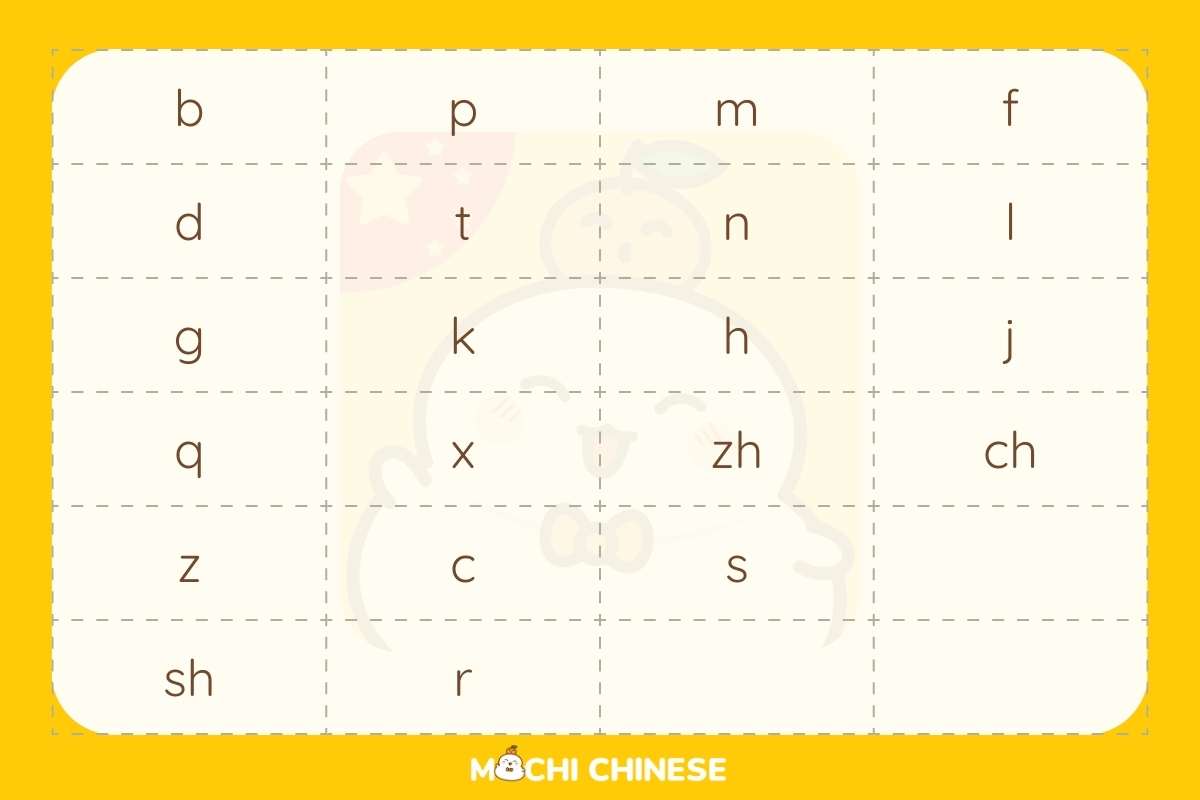
III. Learning Finals (Vowels)
35 finals in Mandarin Pinyin and pronunciation guide for each final
At the heart of pinyin system lie the “finals,” or 韵母 (yùnmǔ), which represent the vowel and nasal sounds that follow the initials in a syllable. Let’s delve into the finals in the Pinyin system
- a (a): Similar to the “a” in “father”. Example: “mā” (妈 – mother).
- o (o): Similar to the “o” in “go”. Example: “Wǒ” (我 – I).
- e (e): Similar to the “uh” sound. Example: “lè” (乐 – happy).
- ai (ai): Similar to the “ai” in “aisle” Example: “ài” (爱 – love).
- ei (ei): Similar to the “ay” in “say.” Example: “lèi” (累 – tired).
- ao (ao): Similar to the “ou” in “mouse” Example: “dào” (到 – to arrive).
- ou (ou): Similar to the “ou” in “go” Example: “gǒu” (狗 – dog).
- an (an): Similar to the “an” in “swan” Example: “bàn” (办 – to handle).
- en (en): Similar to the “an” in “another” Example: “fēn” (分 – to divide).
- ang (ang): Similar to the “ong” in “song” but open your mouth more widely Example: “yáng” (羊 – sheep).
- eng (eng): Example: “Mèng” (梦 – dream).
- i (i): Similar to the “ee” in “see.” Example: “mí” (迷 – fan).
- ia (ia): Similar to the “ya” in “yawn.” Example: “jiā” (家 – home).
- ie (ie): Similar to the “ye” in “yes.” Example: “jié” (节 – festival).
- iao (iao): Similar to the “yow” in “yowl.” Example: “miǎo” (秒 – second).
- iu (iou): Similar to the “yo” in “yo-yo.” Example: “liù” (六 – Six).
- ian (ian): Similar to the “yen”. Example: “tiān” (天 – day).
- in (in): Similar to the “in” in “pin.” Example: “xīn” (心 – heart).
- iang (iang): Similar to the “yang”. Example: “liàng” (量 – to measure).
- iong (iong): Similar to the “yong” in “Yong.” Example: “qióng” (穷 – poor).
- ing (ing): Similar to the “ing” in “sing” Example: “qíng” (情 – feeling).
- u (u): Similar to the “oo” in “boot” Example: “shū” (书 – book).
- ue: Similar to the “yue”. Example: “juédé” (觉得 – feel)
- ua (ua): Similar to the “wa” in “wasp” Example: “guā” (瓜 – melon).
- uo (uo): Similar to the “wo” in “wonder” Example: “duò” (多 – many).
- uai (uai): Similar to the “why” in “why” Example: “guài” (怪 – strange).
- ui (uei): Similar to the “way” in “way” Example: “huí” (回 – to return).
- uan (uan): Similar to the “wan” in “wan” Example: “tuán” (团 – group).
- un (un): Example: “xún” (寻 – to seek).
- uang (uang): Example: “guāng” (光 – light).
- ü (ü): Example: “lǜ” (绿 – green).
- üe (üe): Example: “yuè” (月 – moon).
- üan (üan): Example: “yuán” (元 – yuan).
- ün (ün): Example: “xún” (训 – to train).
- er (er): Similar to the “ar” in “car” Example: “èr” (二 – two).
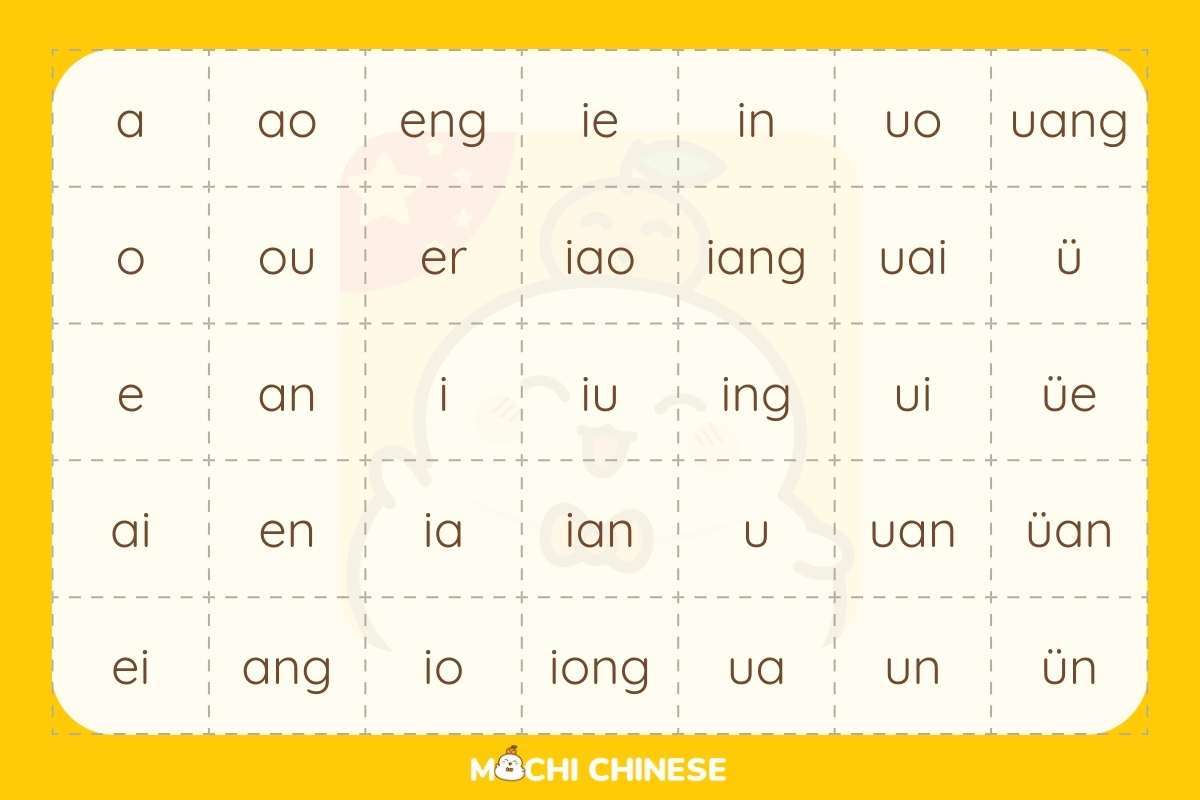
IV. Learning Tones
Tones refer to the pitch contour or musical quality of a syllable when pronounced. The tone in which a syllable is pronounced can change its meaning, even if the other components of the syllable remain the same. For example, the syllable “mā” (with the first tone) means “mother,” while “má” (with the second tone) means “hemp.”
In the Mandarin Pinyin system, there are four main tones and one neutral tone. Each tone is represented by a diacritic mark placed above the vowel of the syllable. Here’s a brief explanation of each tone:
- First Tone (ā): The first tone is high and level. It is represented by a flat line above the vowel. Example: “mā” (妈 – mother).
- Second Tone (á): The second tone is rising, starting from a mid-level pitch and rising sharply. It is represented by a rising diagonal line (/) above the vowel. Example: “má” (麻 – hemp).
- Third Tone (ǎ): The third tone is falling-rising, starting from a mid-level pitch, falling slightly, then rising. It is represented by a curved line (ˇ) above the vowel. Example: “mǎ” (马 – horse).
- Fourth Tone (à): The fourth tone is falling, starting from a high pitch and falling sharply. It is represented by a falling diagonal line (\) above the vowel. Example: “mà” (骂 – scold).
- Neutral Tone: The neutral tone is a shorter, lighter tone that is less emphasized. It is often unstressed and pronounced with a neutral pitch. In Pinyin, it is indicated by not placing any diacritic mark above the vowel. Example: “ma” (吗 – question particle).
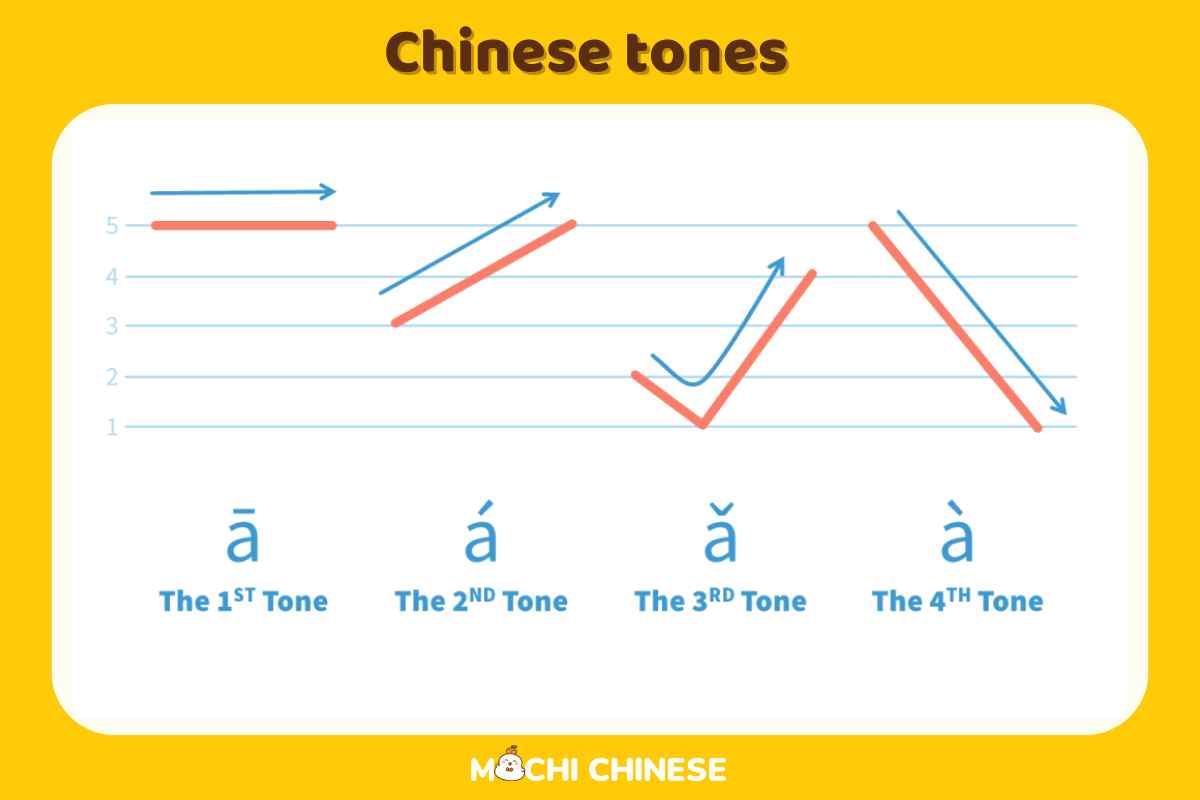
V. Combining Initials, Finals, and Tones
To illustrate the syllable structure, let’s take the Mandarin word “nǐhǎo” (你好 – hello) as an example:
- “n” is the initial consonant.
- “ǐ” is the final, consisting of the vowel “i” with the third tone.
- “hǎo” is another syllable: “h” is the initial consonant, “ǎo” is the final consisting of the diphthong “ao” with the third tone.
Understanding the syllable structure in Mandarin Chinese is essential for proper pronunciation, vocabulary acquisition, and language comprehension. It provides a framework for learners to grasp the fundamental building blocks of the language and communicate effectively in spoken Mandarin.
VI. Learn Chinese Vocabulary easily after master chinese alphabet pinyin
Mastering the pinyin table can help you learn Chinese vocabulary more easily because pinyin provides a standard pronunciation system, you can pronounce new words more accurately, helping you to be more confident when speaking. Pinyin helps you distinguish and remember different vocabulary, you can easily search for new words in the dictionary. However, to build and expand your vocabulary, you need to have scientific and effective learning methods such as learning vocabulary by topic and learning vocabulary with flashcards.
Learn Chinese vocabulary by flashcards
Learning vocabulary with flashcards helps us maximize our senses (Eyes, Mouth, Ears) when concentrating on learning, so we will remember longer and more deeply. Flashcards are compact, you can carry them anywhere, and learn vocabulary anytime, suitable for busy people who do not have much time to study. You can design your own cards according to your preferences or save time by studying on online platforms like Mochi Chinese. The vocabulary in the app appears in the form of flashcards integrated with pinyin, audio, and example sentences to help learners understand the meaning, pronunciation, and usage of words in context.
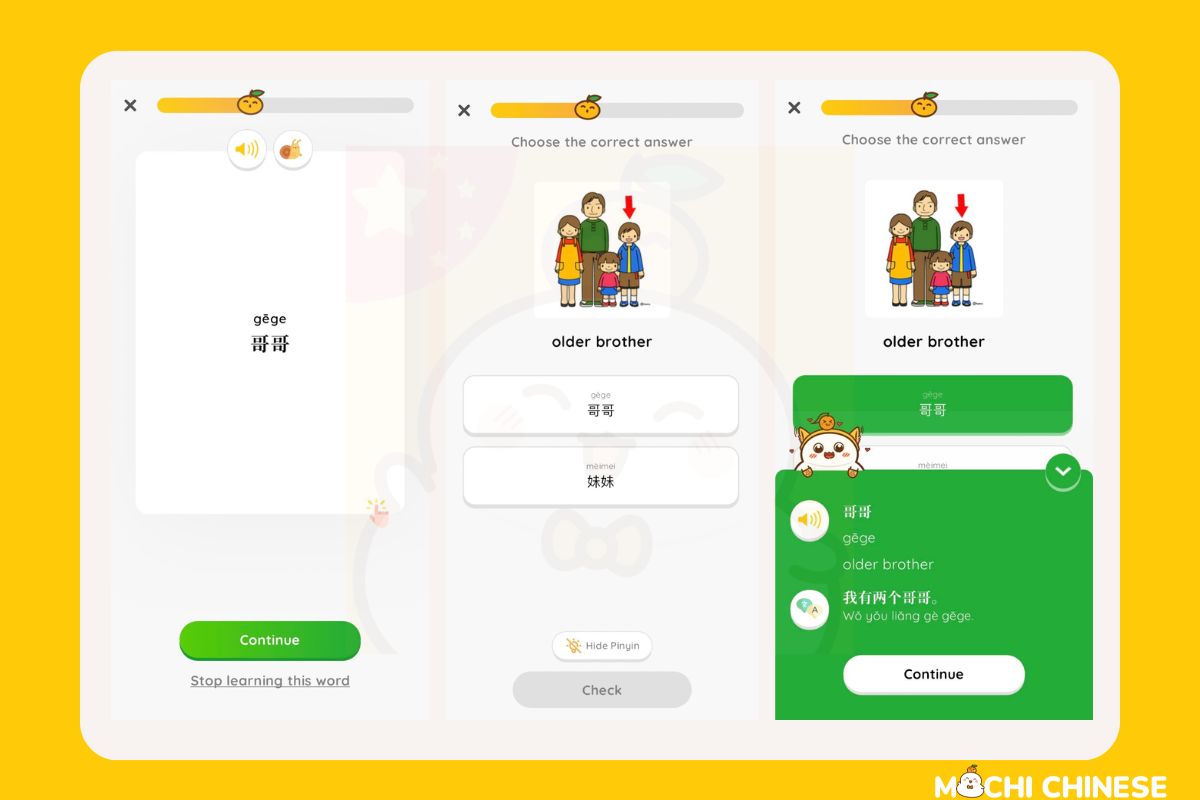
Learn Chinese vocabulary by topics
The method of learning Chinese vocabulary that follows common topics allows you to absorb knowledge in the shortest time. Instead of cramming words that is rarely or never used. Vocabulary in Mochi Chinese is also divided into lessons by topic group to help you memorize more easily and systematically. This helps learners avoid cramming and learning too many words at once, which reduces the quality of the learning process.
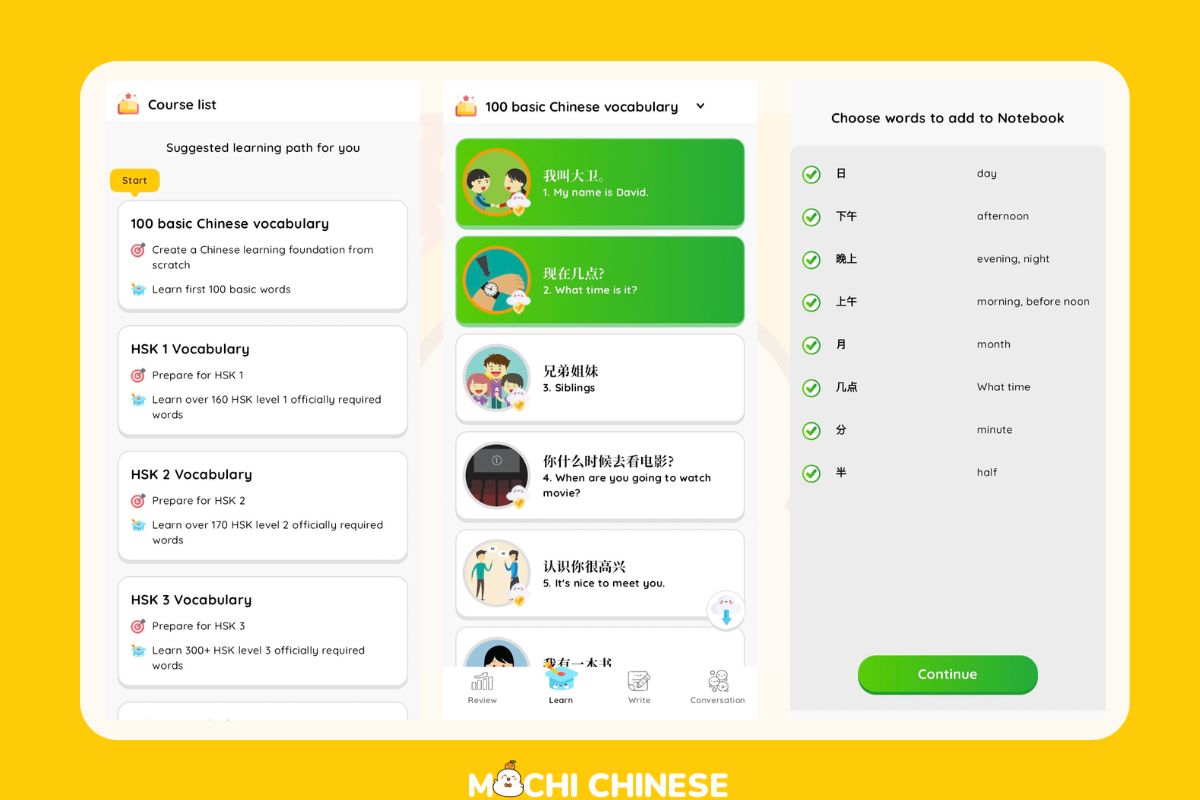
Memorizing effectively with Spaced Repetition method
However, the most important thing is that you must regularly review the new words you have learned. Mochi Chinese will helps you discover the golden time, the most ideal time to review the words you have learned before you forget. Mochi divides the vocabulary you have learned into 5 levels of memorization (from unclear to very clear), to help you review the right words at the right time.
